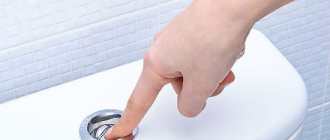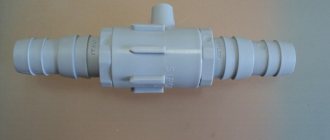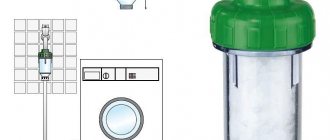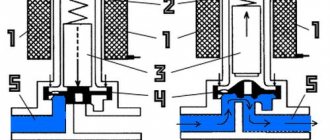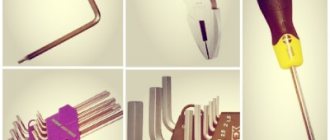People spend about 25% of their monthly liquid consumption on flushing the toilet. A simple solution is a filled bottle immersed in a tank. A hidden valve or plastic fitting secured with a screw helps with this. Many of them prefer new, “economical” models of plumbing fixtures with two unloading modes, reducing consumption up to 4 times. In problematic cases, it is necessary to eliminate the leak or replace individual parts.
Many people try to save money by removing things from their daily lives or sacrificing their comfort. But not all austerity measures are radical. Save money not only on purchases, but also by using resources correctly. A prime example is reducing toilet flush volume. Try some smart yet simple ways to do this and you will see results in the next few days.
Container with liquid
Such a simple tool as a regular plastic bottle with filling (1.5-2 liters) allows you to reduce water consumption in the toilet from the standard 8-9 liters to an acceptable 6 liters.
Simply fill the bottle (any liquid will do, as well as sand or other small material) and place it inside the container. Open the cover and make sure the trigger mechanism is not cut. Try in "new" mode. If there is not enough water, either empty the container by a third or replace it with a smaller one.
Do not put bricks in the tank! This building material tends to dissolve, which is associated with clogged sewers.
The toilet doesn't flush well
How to adjust the toilet if, after a certain point, the flush has sharply worsened?
Cause
If the toilet begins to flush poorly suddenly, literally in one day, and the flush does not depend on how much water is in the tank, most likely something has gotten into the outlet of the tank or the drain of the toilet itself. You understand that adjusting the water level in the toilet tank will not help here.
Most often, this item is a rubber hose from a float valve. It is put on the valve outlet so that water is drawn into the tank silently. Rubber loses its elasticity over time; the hose slides off the valve and starts swimming alone.
Usually, after the next flush, his regatta ends somewhere between the release of the cistern and the toilet bowl. And since water passes through a piece of rubber extremely poorly, we immediately face the consequences.
However, if the tank is without a lid, the most unexpected objects can sometimes be found in the tank outlet. The imagination of preschool children is especially limitless.
And in this case, do not rush to despair
Solution
- Turn off the water to the tank.
- We lift the pear and look under it. If we see a foreign object and can pull it out, great, adjusting the toilet barrel ends there.
- If a hose or any other debris is visible, but not accessible for removal, we look for tweezers.
- Finally, if you still can’t get to the source of our troubles, alas, you’ll have to remove the tank. We take pliers and an adjustable wrench and unscrew the bolts between the tank and the shelf.
Carefully lift the tank (the flexible connection can be left on) and place it on the toilet; To avoid leaving chips, it would be a great idea to put a rag or towel underneath. We extract from the recess in the shelf something that should not be there.
By removing the tank, it is easy to get to the toilet flush
- If your tank has a separate shelf that is not part of the toilet, you can get to the problem area by removing the cuff between the shelf and the tank. It is better to first unscrew the bolts securing the shelf to the toilet: otherwise it will be difficult to remove the cause of the blockage.
The cuff will most likely have to be replaced: as already mentioned, over time the rubber loses its elasticity, and after reinstallation the cuff is likely to leak.
If you have a tank and shelf design like this, you can get to the blockage through the gap between the shelf and the toilet
- After the toilet cistern drain is cleaned and the cistern is assembled, turn on the water and make sure that the drain is working properly and there are no leaks anywhere. This completes the adjustment of the toilet flush tank.
Valve adjustment
Reducing drainage can also be achieved by mechanical means. They boil down to installing a float in the toilet so that it closes the liquid earlier. You just need to press the brass lever. Raise and lower the float - you will see the position in which it shuts off the water supply.
When working with plastic fittings, use a clamping screw or ratchet made of the same material. These elements fix the float in a position that prevents excess water from leaking out. As a result, the tank will not be filled completely, which will reduce the meter readings and save money.
Helpful Tips for Reducing Water Consumption
We use enormous quantities of water for domestic and drinking needs. Get into the habit of turning off the tap when brushing your teeth or shaving. In a couple of minutes, about 10 liters of useless water leak out, and this happens every day. The same advice applies to washing hands and dishes. Open the tap only for rinsing.
We recommend: Disinfection of hot tubs and rules for caring for them
Faucet attachments are an excellent solution that allows you to reduce water consumption by a third or even 2 times. With a mesh nozzle, the stream from the tap does not become thinner, but all thanks to air bubbles. You can wash your hands and dishes under high pressure as usual. A similar nozzle is installed on the shower hose. Another advantage of such a nozzle is that it reduces the amount of splashes and reduces noise when using water.
Install faucets with a common lever. This makes it much easier to adjust the water temperature than using two taps. Time is wasted on setup, and money flows down the drain.
A few more simple saving tips that won’t bother anyone:
- Pour as much water into the kettle as you need at the moment. Repeated boiling is harmful to the device; we still drain the unused water.
- First soak burnt dishes in boiling water and then wash them.
- Don't machine wash pairs of socks and T-shirts if you can wait until the drum is completely full.
- Some dishes just need to be rinsed rather than applying washing gel to them. More water is required to wash off the foam.
How to reduce hot water consumption
Since the New Year, prices for housing and communal services have once again soared. And therefore it makes sense to save at the expense of those resources that are supplied to the house by meters. Hot water is very expensive. Install a tank water heater in your bathroom or toilet.
Modern models consume little electricity (the water is rarely heated, mostly it remains hot due to the design of the tank). For a family of three or four people, a 30-liter device and a mode not exceeding 60° are sufficient. Especially if you follow small tricks: turn off the water while you massage your head with shampoo or rub yourself with a massage washcloth, while you use a toothbrush, etc.
We recommend: How to clean an old shower hose so it shines like new
Saving water does not mean being greedy. Simple settings will help resolve the issue quietly. For the most advanced, there are water-saving household appliances - washing machines and dishwashers, various faucets, toilet tanks with two flush modes. All this, along with simple and inexpensive life hacks, should become part of the life of a person interested in ecology and finance.
Repairing leaks
You can reduce your toilet water consumption by eliminating leaks in the system. This is one of the most common problems with overpayments for utilities among Russian citizens. In addition to wasting water, condensation forms on the pipes, mold, mildew, rust and limescale build up in the toilet, adding to the discomfort. The reason is that the ball that closes the drain in the tank has lost its flexibility. Load it by hanging nuts, lead weights or cast iron sleeves on both sides. In advanced cases, the bulb will need to be replaced.
If the cause of excess water is the float valve is bent (it simply does not shut off the liquid over time), bend the lever to close it 2 cm below the overflow.
These simple solutions are available to everyone. In addition to the financial benefits, you will show concern for the environment. And what kind of solution to the problem - improvised or with the help of innovative mechanics - is up to you to decide.
"Peak hour"
Residents of apartment buildings are familiar with pressure drops when, at certain times of the day, pumps operate with greater power, providing water to the upper floors. Adjust the float during such periods (when the pressure is much higher than at other times).
Fix the float a couple of centimeters lower than usual
At minimum pressure, the lever will shut off the water a couple of centimeters below. By fixing the valve, the tank can be used without problems even with long and low filling.
Rules for water procedures
If you have already decided to save, then you need to do it correctly and thoughtfully. Experts have proven that most of the water consumption is for water procedures, that is, showering, bathing, personal hygiene, etc. Let us bring to your attention a number of habits, the use of which in everyday life will allow you to obtain the expected effect from the actions performed:
- Taking a shower is much more economical than taking a bath;
- It is worth turning off the water during water procedures when there is no need for it. For example, during shaving, applying scrub, brushing teeth, etc. Use a glass to rinse your teeth rather than using your hands to rinse your teeth.
Indeed, why and where does water flow while you brush your teeth? In a couple of minutes, several tens of liters leak! And so every day.
For greater effect, you can hang a reminder in the bathroom about saving water. A visual reminder acts on responsibility, and as a result, savings per year can reach large amounts.
How to use the infrared sensor
A modern water saving device - an infrared sensor - will teach you how to save water. Many have seen and used such a device in shopping centers, hotels, restaurants, public toilets and the like. The infrared sensor can be installed at home.
Infrared mixers have some advantages:
Why is water consumption decreasing? A large amount of resources is spent while a person brushes his teeth, shaves, washes dishes, does not want to dirty the faucet with dirty hands, or is simply lazy. This problem goes away on its own with an infrared sensor. When you raise your hands, you turn on the water, when you remove it, it turns off.
Faucet with infrared sensor
- efficiency: per family, water savings per month will be 10 cubic meters. The faucet does not leak or drip. With a water meter, you can get bills several times lower than usual;
- durability of the device: it does not have a valve that needs to be constantly turned, there are no parts that can wear out and fail;
- safety: water is supplied from the tap at the optimal temperature, it is impossible to get burned. The faucet has a built-in temperature regulation system, which is especially useful in families with children;
- disinfection: since people do not touch the tap with their hands, there is no possibility of transmitting bacteria to each other through household means. Personal hygiene is maintained.
- expensive compared to a regular faucet. The solution is to purchase an attachment with an infrared sensor for a regular mixer;
- difficulty in maintenance. Few plumbers will be able to repair such a system. But warranty service is usually provided for up to 10 years.
Using a washing machine and dishwasher
Few people know that consumption can be reduced only by reading the instructions for household appliances. The instructions for use clearly state recommendations for optimal operation, adhering to which it will be possible to minimize the level of liquid supply.
Washing machine
Now energy-saving models predominate on the market, in other words, manufacturers are already thinking for you. Recommendations for rational use:
- Monitor the drum loading level. On average, 1 kg of laundry consumes 10 liters of water. That is, if a machine has a 5 kg drum, and you only put 2 kg in there, all the free space will be filled with excess water.
- Mode selection. A noticeably smaller volume of water will be required for washing in the “economy” or “cotton” mode, but the “delicate wash” requires a larger volume of liquid, which is responsible for preventing damage.
Use two drain modes
Savings on flushing are possible if a separate flush system is installed on the toilet cistern. Those. There are two modes: full and small flush. The system consists of two buttons - large and small.
With their help, the consumption level in economy mode is only 3-4 liters. If it is necessary to drain the entire contents of the tank, the user just needs to press the large button responsible for concentrated draining.
Faucet attachment to save water
An aerator is a device designed to restrict water flow. Its function is to saturate the water with air bubbles, due to which the pressure becomes smaller and the size of the jet remains the same. This simple faucet attachment can save you up to 40% on your water bills! You can buy an ordinary household aerator nozzle at a hardware store for only 30 rubles. Of course, you can find more expensive models, but they will not differ radically, because... The operating principle is the same for everyone.
You can install the nozzle yourself; this does not require special skills or knowledge. The aerator is simply screwed onto the tip of the tap.
Experts advise
You can also listen to advice from professional craftsmen so that the adjustment process does not cause noticeable difficulties.
Vlad Lazutin, plumber: in order to avoid frequently having to repair the tank fittings, it would not be superfluous to carry out a preventive inspection of the drainage mechanisms in advance. As a rule, it is enough to inspect the structure for mechanical damage only once a year.
Andrey Karpov – plumbing equipment repair specialist: If there are any problems with the drainage mechanism, then under no circumstances should you delay the repair. Over time, delay can lead to a sudden breakdown of the valve, or to the fact that in your absence, water will begin to flow uncontrollably into the tank, causing an overflow - and then expensive bathroom repairs cannot be avoided. Not to mention the fact that there is a high risk of flooding the neighbors below.
Alexander Emelin, plumber: since all the components of the cistern fittings are made of plastic, significant efforts cannot be made during repairs or adjustments. There is a risk of damaging the fragile structure.
LiveInternetLiveInternet
—Tags
—Categories
- knitting (4253)
- sweet life (3597)
- to the delight of meat eaters (3135)
- sore point (2704)
- amazing baked goods (2443)
- I will be better. (2270)
- let's have a snack (2194)
- let's hit the vegetables (1624)
- cellar (1488)
- tips for life (1281)
- not a day without salad (1147)
- fish day (868)
- unusual dessert (843)
- outdoors, in the garden and vegetable garden. (806)
- poetry of colors (803)
- sewing and cutting (653)
- holiday (562)
- I will lose weight 100% (498)
- alluring world of flowers (487)
- handmade (427)
- what's first? (410)
- the pain of the soul flowed onto the paper (381)
- music inside us (319)
- interesting story (287)
- wine cellar (284)
- please speak (261)
- interior (185)
- we fast tasty, satisfyingly, with pleasure (183)
- books, films (182)
- PunchMorsCocktail (154)
- like an echo of days long gone (photo) (125)
- bread is the head of everything (115)
- pizzeria at home (112)
- tea break (81)
- coffee aromas (80)
- a thought appeared (77)
- cooking from. from appetizer to dessert (62)
- we study ourselves (35)
- in palms - crumbs (26)
- computer help (5)
—Search by diary
—Subscription by e-mail
-Statistics
Use of household appliances and modern plumbing
Saving at home consists not only in using fewer natural resources, but also in the correct operation of household appliances, plumbing fixtures and specialized devices, and the installation of meters.
Firstly, all plumbing and pipes in the apartment need to be repaired. No rules will help if excess water constantly flows. All leaking faucets must be replaced and the faucet must be tight after use. Dripping from the tap leads to water loss of up to 24 liters per day, respectively up to 4000 liters per month
Secondly, plumbing fixtures and household appliances must be modern. New developments by technologists make it possible to minimize water consumption with high efficiency. It is also better to delegate household chores to household appliances. And it’s not at all a matter of reluctance to wash dishes and wash clothes by hand; in fact, dishwashers and washing machines use much less water. The consumption of water and detergents is reduced, and time is freed up.
Although top-loading washing machines are cheaper, side-loading machines can use three times less water. When washing, you need to load the household appliance to the maximum, adjusting the water supply level. The following water-saving device can significantly reduce water consumption in an apartment and office: a water-saving aerator nozzle (water flow regulator for shower systems). The savings will be noticeable if there are meters.
